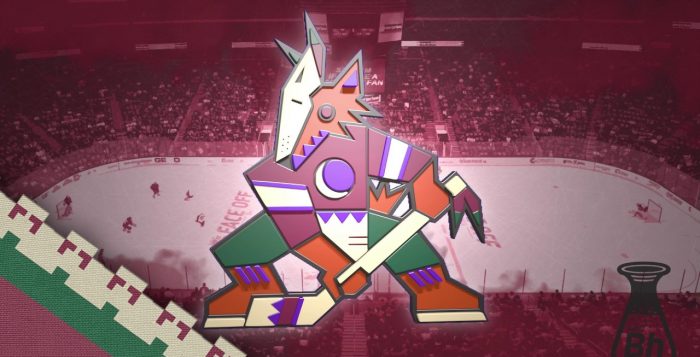This Day in Hockey History – April 8, 1996 – Coyoteman Jets to Arizona
Throughout hockey history, when times get hard, franchises consider moving to new locations to improve their fortunes. Some transitions show few other changes, like when the Minnesota North Stars dropped the word “north” so that the Dallas Stars kept nearly the same logo after the move. On opposite end of the spectrum, the border-crossing relocation from Winnipeg to Phoenix inspired a complete overhaul in name, colors, and logos. Those changes were revealed at a five-hour event held at the team’s new home, the America West Arena, on April 8, 1996.
The Winnipeg Jets had originally belonged to the WHA before being brought over into the NHL at its dissolution in 1979. In the 1990s, player salaries increased with liberal free agency rules, and operating costs skyrocketed. At the same time, players could demand to be paid in U.S. dollars even though revenue came in the increasingly weaker Canadian dollar. Once the Quebec Nordiques relocated in 1995, Winnipeg had the smallest NHL market in Canada with one of the smallest and inadequate arenas in the NHL. Thus, even Winnipeg’s strong fan support could not support the franchise. After several failed attempts to keep the team, a group including Jerry Colangelo, owner of the National Basketball Association’s Phoenix Suns, bought the franchise for $65 million in December 1995 and made plans to relocate them to Phoenix, Arizona. The Jets played their final game at Winnipeg on April 28, 1996, and that July, they made the move south.
The new owners held a contest to rename the team. They had already tossed around options like Wranglers, Outlaws, Mustangs, and Freeze. The public name-the-team contest drew over 10,000 entries. Of them, the top two names were Coyotes and Scorpions, both representative of the Sonoran Desert. Although Scorpions were a strong runner-up, the efforts of the logo design team solidified the decision to call the team the Phoenix Coyotes. They then held a drawing for those who had entered Coyotes into the contest. As a result, 17-year-old Brett Thornton won a pair of lifetime season tickets. He told the press, “It’s not as drab as a lot of other NHL names. I like it. I think it’s pretty cool.” Two other winners received a pair of season tickets for the first season and a trip to the Jets’ season-finale.
To unveil the new team name, colors, and logo, the franchise hosted five hours of events at America West Arena. According to the Arizona Republic coverage, “Most of them [the fans] took a seat in the arena as the official unveiling was made amid smoke, rock and roll and fireworks.” Shawn Hunter, the chief operating officer for the club’s new owners, announced the contest-winning name to a “warm welcome,” though Scorpions actually seemed to receive a better response. That did not seem to stop fans from rushing to “buy team merchandise the minute after the name and logos were introduced.” Fans also had the chance to win prizes, play hockey video games, and skate.
To represent the Coyotes, the unveiled logo showed, according to the Arizona Daily Star, “an upright coyote wearing an extra-long mask styled to resemble a menacing Hopi kachina figure from Northern Arizona.” Internally referred to as Coyoteman, he was designed by NHL creative designer David Haney and the Phoenix design firm Campbell Fisher Ditko. Hunter enthusiastically proclaimed, “This design is an outstanding, unique design in sports, and certainly in Phoenix sports. It captures the Southwest beautifully, and it’s really going to make its mark throughout the league.” Coyotes co-owner Richard Burke commented that “from a creative standpoint, it’s different from what else has been done. We’re pleased with it, and we think the league will be pleased with it.” The other mark with the coyote was a crescent moon meant to look like a “C.” As for colors, those too aimed at the Southwest theme, incorporating “purple, brick, dark green, sand and black.”
Since then, the Phoenix Coyotes have faced more challenges and changes. In 2003, they moved to the suburbs to play at Glendale’s Gila River Arena. Six years later, in 2009, the owners declared bankruptcy, and the NHL took control of the franchise. The team was finally settled with a purchase by IceArizona Acquisition Co., LLC and a 15-year lease agreement with Glendale. The next year, on June 27, 2014, the team changed its geographic name to Arizona to, as co-owner Anthony LeBlanc explained, “encourage more fans from all over the state, not just the valley, to embrace and support our team.”
Meanwhile, in 2011, the Atlanta Thrashers relocated to Winnipeg and chose to honor its previous team by taking the name Jets. Although the colors and logos changed, the Winnipeg Jets had returned to the NHL even as the Arizona Coyotes continued on south of the border.
Additional Sources:
- Stephen Laroche, Changing the Game: A History of NHL Expansion (Toronto: ECW Press, 2014), 321.
- “A new team to howl about” and “Coyotes are born” and “Fans go wild over Stanley Cup,” Arizona Republic, 8 April 1996, pp. A1 and D1-D2.
- “Multicolored Coyotes will roam ice as Phoenix NHL team,” Arizona Daily Star, 9 April 1996, p. 5.
- https://www.nhl.com/news/nhl-team-nickname-origins-explained/c-283976168?tid=277548856














